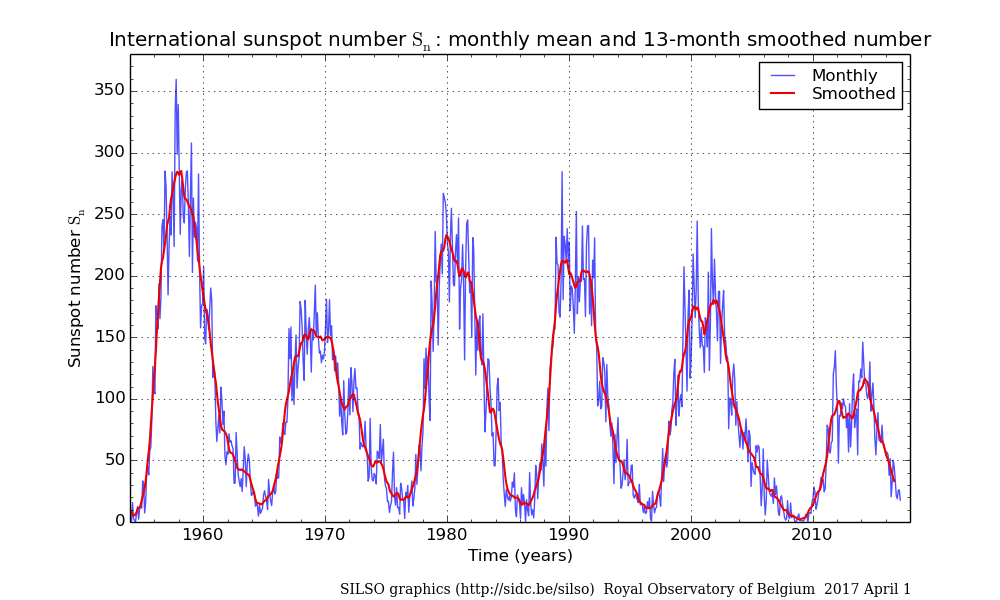太阳正处于1750年以来的第24太阳活动周,本活动周中太阳活动水平明显偏低,可能预示着太阳将进入一段较长的平静时期。在第24周开始之前的2008年,太阳活动就已处于极不活跃的水平,被称为太阳活动极低年,它与平常的太阳活动低年(如1996年)之间有多大的差异,是一个非常有趣的问题。
 近6个太阳活动周的黑子数记录
近6个太阳活动周的黑子数记录
地球的高层大气吸收太阳极紫外辐射(EUV)的能量而形成热层和电离层。对太阳EUV辐射的直接测量需使用运行于大气层之外的卫星,目前可提供此类观测的仪器包括SOHO飞船上的SEM(Solar EUV Monitor)、TIMED卫星搭载的SEE(Solar EUV Experiment)及SDO卫星上的EVE(EUV Variability Experiment)。其中,SOHO SEM的观测数据历史最长,可用于对第23和24太阳活动周进行比较研究,实际上它已被多次用于研究2008年和1996年之间的EUV辐射差异。然而,在以往的研究中也发现SOHO SEM的数据可能存在长期的偏差,导致其给出的结果可能是不准确的。
黄建平等利用上述卫星观测及电离层观测数据,对SOHO SEM的数据进行了细致的检验。通过比较SOHO SEM的数据比TIMED SEE和SDO EVE,发现前者观测值偏低,且偏低的趋势从2004年开始随时间逐渐增大。到了2008年,SOHO SEM的观测数据已经比TIMED SEE偏低了10%。同时,引入电离层观测数据(F2层最大电子浓度NmF2)进行交叉验证,因为EUV辐射作为产生电离层的直接因素,其通量应当与电离层电子浓度呈现正相关关系。结果表明SOHO SEM数据与NmF2之间的线性关系确实有异常之处,如下图所示。
相同的NmF2水平,对应的SOHO SEM的数据在第24周较低,说明SOHO SEM的观测确实存在长期缓慢偏低的趋势,该趋势可能是因为在数据标定时没有完全去除仪器本身长期退化的影响,这个趋势大概为-2%/年。修正上述趋势以后,重新用SOHO SEM数据对1996年和2008年的EUV辐射进行了比较。结果表明后者比前者低10%,而用未修正的数据得到的结果为18%。对太阳EUV辐射变化的准确估计,有助于更深入了解其对太阳活动“极低年”期间热层大气密度和电离层电子密度的作用机制。
 分别以SOHO SEM与TIMED SEE 0.1-50nm光子数通量为参考,三个台站的NmF2在两活动周间的比较(SC24为红色,SC23为蓝色)
分别以SOHO SEM与TIMED SEE 0.1-50nm光子数通量为参考,三个台站的NmF2在两活动周间的比较(SC24为红色,SC23为蓝色)
上述工作发表在Journal of Geophysical Research: Space Physics上,文章作者为:黄建平,郝永强,张东和,肖佐。
Huang, J., Y. Hao, D. Zhang, and Z. Xiao (2017), Revisiting interminima solar EUV change using adjusted SOHO SEM data, J. Geophys. Res. Space Physics, 122, doi:10.1002/2016JA023664.
Revisiting interminima solar EUV change using adjusted SOHO SEM data
Jianping Huang, Yongqiang Hao, Donghe Zhang, and Zuo Xiao Department of Geophysics, Peking University, Beijing, China
Abstract
The change of solar EUV irradiance between the 1996 and 2008 minima is still in active debate due to a possible trend in the data from the Solar EUV Monitor (SEM) on board the Solar and Heliospheric Observatory (SOHO). For the period of years 2002–2012, i.e., the descending phase of solar cycle 23 (SC23) and the ascending phase of SC24, concurrent observations from the Solar EUV Experiment (SEE) on board the Thermospheric Ionospheric Mesospheric Energy and Dynamics spacecraft are available. We compare the data from the two instruments in terms of an expected linear relation between the EUV irradiance and the ionospheric peak electron density (N m F 2). For the SEE data the N m F 2-EUV function is solar cycle invariant, but for the SEM data the function is found to be different between SC23 and SC24, which is hard to explain at present. An attempt is therefore made to obtain a unbiased SEM data set by using the SEE data as a calibration source. As a result, a temporal sensor drift coefficient of∼−2%/yr is fitted, and the trend causing the unnatural solar cycle different N m F 2-EUV function is removed from the data. A new estimation of the interminima change of EUV irradiance based on the adjusted SEM data is ∼10% reduction in 2008 compared to 1996, much smaller than previous results. After adjustment the SOHO SEM could continue to be a reliable data source for solar EUV and aeronomic studies over both SC23 and SC24.

